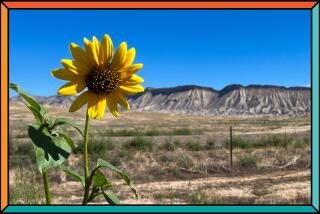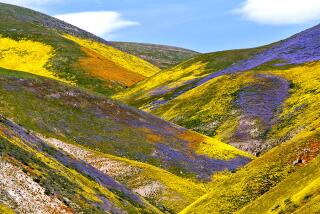Nurturing gentle giants
What is it about the sunflower -- the bloom that Vincent van Gogh immortalized, that Kansas bestowed state honors on, that the avian crowd treats as a neon welcome mat -- that brings an instant smile to children’s faces?
“It’s the most human-looking of all plants,” says Larry Kleingartner, executive director of the National Sunflower Assn. “They look like they are alive. Most grow to human height, and when they are in bloom their leaves look like arms, and you have this smiling, cheerful face looking at you.”
But therein lies the rub: The smiling, cheerful face doesn’t always look at you. Although a growing sunflower will follow the sun from morning till nightfall, a mature plant will face east to protect its seeds from the hottest rays of the sun. Hence, many gardeners are treated to the backside of their labors. Perhaps sunflowers are more human-like than we care to admit?
Anthropomorphism aside, perhaps no plants are better for a children’s garden than gentle, giant sunflowers. They are easy to grow and rapidly become exclamation points in a home’s landscape.
“I think children are drawn to them for three reasons,” says Yvonne Savio, manager of the University of California Cooperative Extension’s Common Ground Garden Program, which promotes gardening among all ages. “First, the scale -- they are just these big monsters towering over them -- then the bright yellow color and the idea that it makes seeds that we can actually eat.”
Sunflowers are so popular with children, says Dorie Woodworth, head of the Gardening Angels program at Webster Elementary School in Malibu, that she had her eager first-graders plant them in pots in February, although planting later in spring is optimal. The children planted ‘Mammoths’ for their dramatic size as well as a few dwarfs.
“Children just love sunflowers,” Woodworth says. “We plant them a bit earlier than we probably should, but I want them to bloom before school lets out for the summer.”
For Topanga gardener Shannon McGiffert and daughter Natalie, 8, sunflowers are a springtime tradition. About a week before Natalie’s birthday in March, the two carefully line flats with newspapers and potting soil and sprinkle in a generous amount of seeds.
“We take a ‘the-more-the-merrier’ attitude,” McGiffert says, “allowing for the half that don’t actually work out.” They bring the flats inside at night to foil the vermin that see a buffet.
“Sunflowers really look like the sun, and I like that,” Natalie says.
Woodworth recommends more precise planting guidelines for gardeners not in a rush to see blooms. She advises mixing soil with several inches of compost in a garden plot and planting the seeds about half an inch deep in rows about a foot apart.
“The kids use their math skills, dividing the size of the plot to see how many seeds can be planted,” she says.
They also must understand the flower’s aforementioned tendency to face east, and then, of course, there are the history lessons: Native Americans used parts of the sunflower plant to treat rattlesnake bites, and made bread from sunflower meal. Spanish explorers are said to have brought back sunflower seeds from the New World in the 1500s. How about some science? Sunflowers planted on plastic foam rafts in contaminated ponds near the 1986 Chernobyl nuclear power plant accident absorbed some of the ponds’ radioactivity, making the flowers an unsung hero of the cleanup effort.
Helianthus annuus, the common sunflower, must be planted in full sun and the seedlings kept well-watered. But don’t allow it to shade other sun worshipers in the garden.
Giant sunflowers are the most fun to grow, but they require more work. The ‘Mammoth Russian’ giants with their Frisbee-size flowers and sapling-like stalks, or the ‘Kong’ sunflowers that reach 10 to 15 feet in height, need stake support and do best near a fence or a garage that can anchor them.
These tall, single-stem varieties bear 12-inch flowers and produce the greatest number of seeds -- up to 900 per head. The super-sizing trend also can be seen in the ‘Super Snack’ hybrid, which has extremely large seeds.
But in small gardens or classrooms, the yellow-flowered ‘Teddy Bear’ variety, which grows only 18 inches tall and has a full fuzzy look, works well. Or there is ‘Tangina,’ another dwarf, which bears light orange flowers with dark centers.
‘Sunspot’ stays within the 2- to 3-foot range but boasts large flower heads up to 10 inches. These shorter sunflowers can be planted anywhere in the garden, and their lower height reduces the chance that they will topple in the wind.
Sunflowers grow best in soil that is slightly acidic to slightly alkaline (pH 6 to 7.5). They tolerate drought, befitting a plant whose ancestors grew happily in dry prairie regions. They even plant themselves, popping up unbidden beneath bird feeders.
Michael Kerkman, a botanical educator at the Huntington gardens in San Marino, recently spotted clusters of wild sunflowers along the 134 Freeway.
“Nothing especially dramatic, but just enough first-of-the-season sunflowers to make you smile,” Kerkman says.
Sunflowers pop out of the ground in seven to 10 days, satisfying the instant gratification needs of children. At this early stage, the seedlings need protection from birds and other animals. A little tent of chicken wire or a milk jug with the ends cut off keep predators away.
Within 80 days, the flowers usually are showing their impressive size. For the seriously impatient, a few varieties bloom in 50 days. The ‘Sundance Kid Dwarf’ is one of the fastest to mature and grows well in containers.
With sunflowers, you can have your bloom and eat it too. Seeds are a tasty snack. What you don’t harvest, the birds will. Many gardeners leave the seeds to them anyway, replacing the flowers’ joyous color with the delight of song.
*
(BEGIN TEXT OF INFOBOX)
Harvesting seeds
Remove the seed head with about a foot of stem attached. Hang it upside down in a warm, dry, airy place. Cover the head with a paper bag or cheesecloth to catch seeds as they drop.
Soak the unshelled seeds in saltwater overnight, using about half a cup of salt for every two quarts of water. Drain, and dry with paper towels. Put the seeds in a shallow pan or on a cookie sheet and roast them at 300 degrees for 30 to 40 minutes or until they turn golden brown. Toss them with melted butter and salt.






